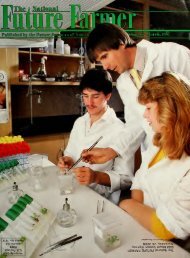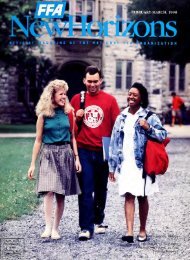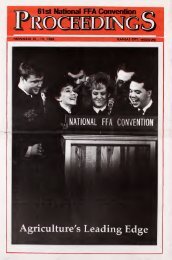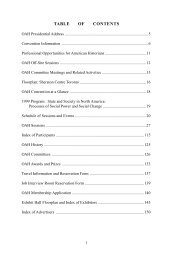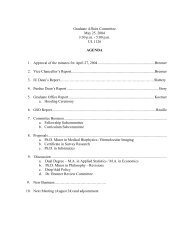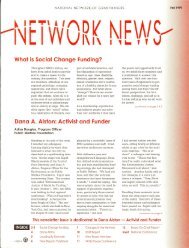Create successful ePaper yourself
Turn your PDF publications into a flip-book with our unique Google optimized e-Paper software.
RECENTLY<br />
a truck rumbled into<br />
a Los Angeles gas station and<br />
rolled up to the pumps located<br />
under a portico. Suddenly, the sta-<br />
tion's wooden columns melted to the<br />
ground, the roof collapsed, and the<br />
whole structure was literally reduced<br />
to shambles.<br />
Those insidious '"borers from within"<br />
—termites—had been at work, honeycombing<br />
the inside of the beams until<br />
the building became a paper-thin skele-<br />
ton. Invariably these wood-eating insects<br />
stop feasting just before a beam<br />
has been weakened enough to crash<br />
and betray them. In this case, however,<br />
the vibrations created by the truck<br />
triggered the crumbling of the en-<br />
feebled building.<br />
Harmless as they appear, the ter-<br />
mites are one of the most destructive<br />
forces on this planet. Ranging in the<br />
same general sizes as ants, they silently<br />
and invisibly sabotage the works and<br />
crops of man. Their powerful jaws<br />
chomp at woodwork, beams, pier<br />
pilings, telephone poles, and flooring, as<br />
well as clocks, pianos, boats, shoes,<br />
baseball bats, and railroad cars. In<br />
their wake, houses crumble away, fur-<br />
niture disintegrates, and clothing is reduced<br />
to dust. It is estimated that in<br />
the United States alone termites cause<br />
an annual $100 million worth of de-<br />
struction.<br />
In general, these blind, quarter-of-<br />
an-inch long, soft-bodied creatures lead<br />
a highly-organized community life. The<br />
caste system is a definite reality in the<br />
termite scheme of things. Each colony<br />
is composed of three adult groups: the<br />
soldiers, the workers, and the royalty,<br />
each group having its own specialized<br />
duties. To round out the population,<br />
there are the young, or nymphs, which<br />
may develop into any of the three adult<br />
groups.<br />
The soldiers play a purely protective<br />
role in this society. One type has<br />
pincer-like jaws, or mandibles, with<br />
which to crush the enemy. Another<br />
44<br />
Those Terrible Termites<br />
They sal)otage the works of man while living a highly organized<br />
connnnnity life which includes soldiers, workers, and royalty.<br />
species is equipped with an eflfective<br />
weapon in the form of a sticky fluid<br />
which it carries in a gland in its head.<br />
The soldier ejects the fluid through a<br />
snout-like prolongation. When ejected,<br />
this material forms a sticky semiliquid,<br />
acid substance which covers<br />
attacking ants, or other enemies, and<br />
renders them helpless. Still other ter-<br />
mites have spurs on their thorax as<br />
supplementary armament.<br />
"When a soldier termite senses danger,<br />
possibly by noticing a strange odor, it<br />
thumps its head on the floor—a seemingly<br />
crude method for sending an SOS.<br />
Yet, this system gets results, for other<br />
soldiers rush out to meet the danger.<br />
Often, the soldiers plug holes in the<br />
walls of their colony with their heads.<br />
This forms an almost impenetrable<br />
barrier.<br />
The industrious termite workers perform<br />
all of the community's labor.<br />
They gather the food and feed it to<br />
the queen and to other termites. Even<br />
the soldiers must be fed because their<br />
huge jaws, so useful for defense, are<br />
of no help in providing food. Most<br />
of the damage caused by termites is<br />
performed by the workers with their<br />
By Frank L. Remington<br />
saw-toothed jaws as they chew wood.<br />
The little creatures thrive on the cellulose<br />
in the wood.<br />
In their food-providing duties, the<br />
workers care for their domesticated<br />
insects, which are milked for their<br />
secretions, just as we keep cows for<br />
milking. These domesticated insects<br />
are beetles and flies, and over 500<br />
species have been identified in various<br />
termite colonies. Another source of<br />
food for termites is their fungus gar-<br />
dens. The workers tend these gardens,<br />
cultivate them, harvest them, and dis-<br />
tribute the crops.<br />
In addition to their ""breadw inning"<br />
duties, the workers must care for the<br />
young and enlarge and extend the nest.<br />
Termites make their nests either in<br />
subterranean chambers in the soil, in<br />
wood, or in elaborate nest mounds.<br />
In the latter, the mounds sometimes<br />
rise above the ground and stretch for<br />
many yards under the soil by means of<br />
subterranean passages. Frequently they<br />
link up with other colonies to form<br />
cities, kingdoms, and even empires.<br />
Above the ground, the mounds arc<br />
frequently 25 feet high and 40 feet<br />
wide at the base.<br />
The picture below shows what termites have done to the baseboard of a room.<br />
They are a highly organized insect; even grow crops and keep "cows" for milk.<br />
The <strong>National</strong> FUTURE FARMER





